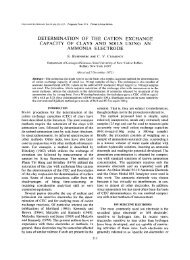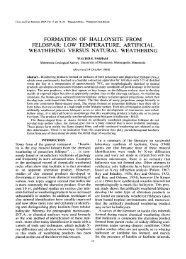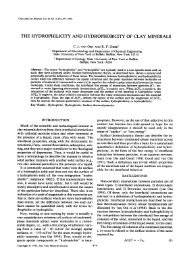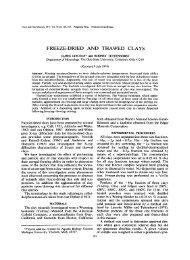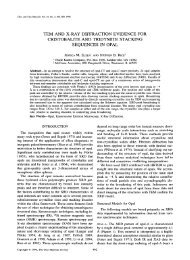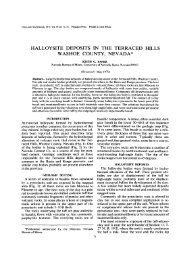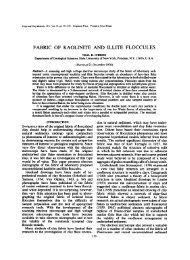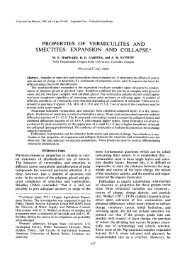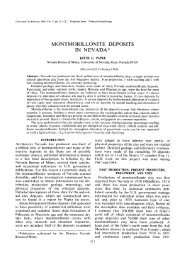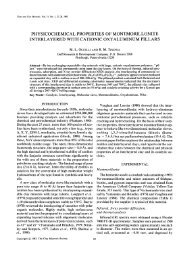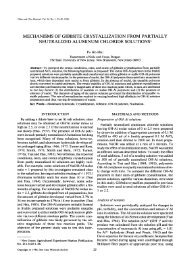mineralogical and geochemical study of clay mineral ...
mineralogical and geochemical study of clay mineral ...
mineralogical and geochemical study of clay mineral ...
Create successful ePaper yourself
Turn your PDF publications into a flip-book with our unique Google optimized e-Paper software.
370 J. LUCAS <strong>and</strong> G. ATAMAN<br />
neutrality. In addition, illite <strong>and</strong> chlorite require<br />
aluminum in order to form. But aluminum, almost<br />
insoluble <strong>and</strong> very immobile, would not be avail-<br />
able in solution in the waters <strong>of</strong> sedimentary basins.<br />
The only <strong>mineral</strong>s actually recognized as certainly<br />
"ne<strong>of</strong>ormed" in sedimentary basins, or synthesized<br />
under normal temperature <strong>and</strong> pressure conditions,<br />
are neutral or approximately neutral. Examples<br />
are attalpugites, sepiolites, <strong>and</strong> probably some<br />
trioctahedral smectites <strong>of</strong> weak, or completely-<br />
balanced electrical charges. Stevensite may be<br />
such an example. They are essentially mag-<br />
nesium <strong>mineral</strong>s. Magnesium, very soluble in<br />
water, is used in the place <strong>of</strong> aluminum in<br />
ne<strong>of</strong>ormation.<br />
Transformation <strong>and</strong> diagenesis<br />
Many arguments exist against the interpretation<br />
that these transformations have occurred during<br />
diagenesis, i.e. after the deposition <strong>of</strong> the sed-<br />
iments. Four which appear to us demonstrative<br />
will be considered.<br />
1. Transformations <strong>and</strong> crystallinity <strong>of</strong> <strong>mineral</strong>s<br />
do not correlate with depth <strong>of</strong> burial. In a single<br />
drill hole, if transformation were diagenetic,<br />
a deterioration <strong>of</strong> crystallinity ought to be found<br />
from the bottom to the top. The opposite is in<br />
fact observed; the best crystallized <strong>mineral</strong>s<br />
occur in the highest levels <strong>of</strong> the Triassic<br />
sediment.<br />
2. Diagenesis by compaction should result in<br />
a decrease in water loss on sample ignition,<br />
formation water having been squeezed out<br />
by increasing overburden pressure. On the con-<br />
trary, the better-crystallized <strong>mineral</strong>s contain<br />
more water in the Triassic Jura sediments.<br />
3. The correlations between certain <strong>of</strong> the trace<br />
<strong>and</strong> major elements (especially vanadium,<br />
nickel, <strong>and</strong> cobalt with magnesium oxide)<br />
are opposite to those observed in metamor-<br />
phism. In addition, the behaviour <strong>of</strong> boron is<br />
readily explained by its introduction into <strong>clay</strong><br />
<strong>mineral</strong>s during- not after- sedimentation.<br />
It is difficult to imagine a diagenetic mechanism<br />
which could homogenize the boron content <strong>of</strong><br />
the sediments on such a large scale.<br />
4. The corrensite-chlorite <strong><strong>mineral</strong>ogical</strong> associ-<br />
ation is not only found in the French Jura.<br />
It is frequently observed in Permian sediments<br />
<strong>and</strong> in European Triassic sediments <strong>of</strong><br />
Germanic facies: Engl<strong>and</strong> (Honeyborne,<br />
1951); Germany (Fuchtbauer <strong>and</strong> Goldschmidt,<br />
1959; Lipmann, 1956); France (Lucas, 1962);<br />
Spain (Martin-Vivaldi <strong>and</strong> MacEwan, 1957;<br />
Lucas, 1962); in the Permian <strong>of</strong> North America<br />
(Grim et al., 1960; Fournier, 1961; Peterson,<br />
1962; Tooker, 1962). This association was also<br />
found recently in the laboratory at Strasbourg<br />
in sediments <strong>of</strong> similar age from South America,<br />
in the formation <strong>of</strong> Karroo age. Such a distri-<br />
bution seems certainly to be the result <strong>of</strong> a sed-<br />
imentary process characteristic <strong>of</strong> a geological<br />
period, <strong>and</strong> not the result <strong>of</strong> a diagenetic<br />
phenomenon.<br />
In conclusion, it appears that <strong>clay</strong> <strong>mineral</strong>s,<br />
degraded by weathering on the continents, are<br />
very sensitive to the sedimentological environment<br />
<strong>and</strong> reflect, by chemical variations, changes in<br />
their environment. Their ability to fix ions from<br />
solutions gives them an important role in the<br />
<strong>geochemical</strong> balance <strong>of</strong> sedimentary basins.<br />
In addition, their susceptibility to transformation<br />
makes them a useful tool in paleogeographic<br />
reconstructions.<br />
Acknowledgments-We wish to thank Dr. Pierre E.<br />
Biscaye <strong>of</strong> the Lamont Geological Observatory for<br />
translating this paper from French to English.<br />
REFERENCES<br />
Ataman, G. (1963) Utilisation du spectrom~tre h lecture<br />
directe pour le dosage des ~lrments majeurs des roches<br />
srdimentaires et des silicates dans une gr<strong>and</strong>e gamme<br />
de concentration: Bull. Serv. Carte g~ol. Alsace<br />
Lorraine 16 233-240.<br />
Ataman, G., <strong>and</strong> Besnus, Y. (1965) Une mrthode de<br />
dosage des ~lrments-traces dans les roches par spectro-<br />
m~trie h lecture directe: Bull. Serv. Carte gdol. Alsace<br />
Lorraine 18 179-189.<br />
Ataman, G. (1966) G~ochimie des minrraux argileux<br />
dans les bassins s~dimentaires matins. Etudes sur le<br />
bassin triasique du Jura: M(m. Serv. Carte g~ol.<br />
Alsace Lorraine 25,237 pp.<br />
Ataman, G., <strong>and</strong> Lucas, J. (1967) Relation entre la<br />
rrpartition des ~lrments dans les minrraux argileux<br />
et la palrogrographie triasique du Jura: Proc. "Sym-<br />
posium on the origin <strong>and</strong> distribution <strong>of</strong> the elements",<br />
Pergamon Press, Oxford, 1968 (~. I'impression).<br />
Degens, E. T., Williams, E. G., <strong>and</strong> Keith, M. M. (1957)<br />
Environmental studies <strong>of</strong> carboniferous sediments.<br />
1 : Geochemical criteria for differentiating marine <strong>and</strong><br />
fresh water shales: Bull. Am. Assoc. Petrol. Geologists<br />
41, 2427-2455.<br />
Fiichtbauer, H., <strong>and</strong> Goldschmidt, H. (1956) Die Ton-<br />
<strong>mineral</strong>e der Zechsteinformation: Beitr. Min. Petr.<br />
6, 325-345.<br />
Fournier, R. D. (1961) Regular interlayered chlorite-<br />
vermiculite in evaporite <strong>of</strong> the Salado formation,<br />
New-Mexico: U.S. Geol. Surv. Pr<strong>of</strong>. Paper 424 D,<br />
323-327.<br />
Goldschmidt, V. M., <strong>and</strong> Peters, C. (1932) Zur Geo-<br />
chemie des Bors: Nach. Gesell. Naturwiss. GOttinger-<br />
Math. Phys. KI., 536 pp.<br />
Grim, R. E., Droste, J. B., <strong>and</strong> Bradley, W. F. (1960)<br />
A mixed layer <strong>clay</strong> <strong>mineral</strong> associated with an<br />
evaporite: Clays <strong>and</strong> Clay Minerals 8, 228-236.



